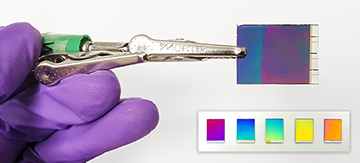Researchers at Chalmers University of Technology have developed a reflective “e-paper”-type display that they say boasts high color quality with minimal energy use. [Image: Marika Gugole/Chalmers University of Technology] [Enlarge image]
Reading electronic displays outside can be a struggle. But that could change with a new type of display that reportedly is brighter than traditional displays and also uses less energy (Nano Lett., doi: 10.1021/acs.nanolett.1c00904).
The display uses reflected light instead of traditional backlighting. Via a dual-pixel design, the display can reproduce a wide range of colors and is easier on the eyes than backlit designs, according to the research team behind the device.
“With the dual pixel design that we propose, a device would be approximately twice as bright as the commercial color e-reader that we compare with,” says coauthor Andreas Dahlin, researcher at the Chalmers University of Technology, Sweden.
Since switching is slow for the devices, the researchers think the display would be well suited for outdoor advertisement boards in bright places, among other applications.
Upside-down display
The new work builds on previous research that used a similar structure with polymers and oxides to produce a display that could show all the colors of an LED screen with less energy. However, the color quality in the original design was lacking, according to coauthor Marika Gugole, a Ph.D. student at Chalmers. “We wanted to find a way to optimize it and make it comparable or better in terms of brightness and color quality to the latest device on the market,” Gugole says.
In the new research, the scientists employed a reversed design that sandwiches a layer of tungsten trioxide between a lower platinum mirror and thin gold layer on top, with all other electronic components below. This nanostructure sandwich creates a resonant cavity where changes to the permittivity of the tungsten trioxide changes the resonance, and thus the reflected color. A combination of two such cavities, created by different tungsten trioxide widths, can create a broad range of colors, with high color quality that typically requires a triad of red, green and blue pixels.
Toward a new era of reflective displays?
Reflective displays are already used in some tablets but are only available in black and white. The Chalmers team believes its design offers a promising color option for commercial use. Cost, however, is still a limiting factor.
The nanostructures used in the display comprise expensive metals like platinum and gold, but since they’re extremely thin, only a few dollars’ worth of metals end up in the final product. However, with current processing techniques, much more metal is used and lost during construction. The researchers hope improved construction methods can be developed to reduce the system price.
“I do think that some kind of reflective display technology will become dominating in the future because it’s the only way to do something about the high energy consumption of existing emissive displays,” Dahlin says.

